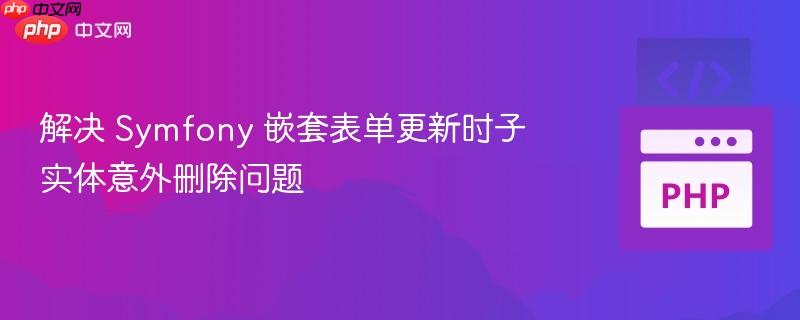
本教程旨在解决 Symfony 应用中,当通过多层嵌套的 `CollectionType` 表单更新父实体时,深层子实体被意外删除的问题。我们将深入探讨 `orphanRemoval`、`by_reference=false` 与实体 `remove` 方法中 `setParent(null)` 调用的交互,并提供一个简洁有效的解决方案,确保数据完整性。
在 Symfony 应用中,处理具有多层级联关系的实体(例如 Folder -youjiankuohaophpcn Board -> Category -> Link)的更新操作时,常常会遇到一个棘手的问题:当通过父级表单(如 FolderType)更新数据时,虽然直接子级(如 Board)的数据得以保留,但更深层次的子级实体(如 Category 和 Link)却可能被意外删除。同样的问题也可能发生在中间层级,例如更新 Board 时,Link 被删除而 Category 被保留。
这种现象通常发生在 CollectionType 表单与 Doctrine 的 orphanRemoval=true 选项结合使用时。开发者期望 orphanRemoval 能够自动处理被移除的子实体,但实际行为却可能与预期不符,导致数据丢失。
为了理解这个问题,我们需要回顾 Doctrine 的 orphanRemoval 机制和 Symfony CollectionType 表单的工作原理。
orphanRemoval=true 的作用: 当在一个 OneToMany 或 OneToOne 关联上设置 orphanRemoval=true 时,Doctrine 会将任何不再与父实体关联的子实体(即子实体从父实体的集合中被移除,或者子实体的外键被设置为 null)视为“孤儿”,并在 flush 操作时自动将其从数据库中删除。
CollectionType 与 by_reference=false: 在 Symfony 表单中,CollectionType 用于处理实体集合。当设置 by_reference=false 时,Symfony 表单组件在处理集合数据时,会通过调用父实体定义的 add*() 和 remove*() 方法来管理子实体集合。这意味着,如果表单提交的数据中缺少了某个原本存在于集合中的子实体,Symfony 会调用父实体的 remove*() 方法来移除该子实体。
*问题的根源:`remove()方法中的setParent(null)** 在许多 Doctrine 实体中,为了维护双向关联的完整性,remove*()方法通常包含一个if ($child->getParent() === $this) { $child->setParent(null); }这样的逻辑。例如,在Foo(Folder) 实体中移除Bar(Board) 的方法removeBar`:
// 在 Foo 实体中
public function removeBar(Bar $bar): self
{
if ($this->bars->removeElement($bar)) {
// set the owning side to null (unless already changed)
if ($bar->getFoo() === $this) {
$bar->setFoo(null); // 这一行是潜在的问题所在
}
}
return $this;
}当 orphanRemoval=true 已经生效时,removeElement($bar) 这一步就足以让 Doctrine 识别到 Bar 实体已被“孤立”,并在 flush 时将其删除。然而,$bar->setFoo(null) 这行代码的作用是显式地将子实体 Bar 的父实体外键设置为 null。在某些复杂的嵌套场景下,尤其是当 CollectionType 处理的是深层子实体时,这种显式设置 null 的行为可能会与 orphanRemoval 的隐式处理逻辑产生冲突,或者导致 Doctrine 在不恰当的时机触发级联删除,从而影响到更深层次的子实体。
例如,当更新 Foo (Folder) 时,FooType 处理 bars (Boards) 集合。如果 bars 集合中某个 Bar 被移除,其 removeBar 方法被调用,其中的 setFoo(null) 会被执行。对于 Bar 而言,它被标记为孤儿,将被删除。但如果 Bar 还有 Baz (Categories) 集合,而 Baz 也有 Qux (Links) 集合,这种显式设置 null 的操作可能在 Doctrine 内部处理这些级联关系时,导致 Baz 和 Qux 也被错误地标记为孤儿并删除,即使它们并没有直接从 Bar 的 bazs 集合中被移除。
解决这个问题的关键在于,当在 OneToMany 关联上已经设置了 orphanRemoval=true 时,remove*() 方法中不再需要显式地将子实体的父关联设置为 null。仅仅将子实体从父实体的集合中移除,Doctrine 就会根据 orphanRemoval=true 的配置来处理子实体的删除。
*修改后的实体 `remove()` 方法示例:**
以下是针对 Foo (Folder), Bar (Board), Baz (Category) 实体中 remove 方法的修改。
1. Foo (Folder) 实体
<?php
declare(strict_types=1);
namespace App\Entity;
use Doctrine\Common\Collections\Collection;
use Doctrine\ORM\Mapping as ORM;
/**
* @ORM\Entity(repositoryClass=FooRepository::class)
*/
class Foo
{
// ... (其他属性和方法)
/**
* @var Collection<int, Bar>
* @ORM\OneToMany(targetEntity=Bar::class, mappedBy="foo", orphanRemoval=true, cascade={"persist"})
*/
private Collection $bars;
// ... (构造函数、getters、setters、addBar 方法)
public function removeBar(Bar $bar): self
{
// 仅从集合中移除,不再显式设置 $bar->setFoo(null)
$this->bars->removeElement($bar);
return $this;
}
}2. Bar (Board) 实体
<?php
declare(strict_types=1);
namespace App\Entity;
use Doctrine\Common\Collections\Collection;
use Doctrine\ORM\Mapping as ORM;
/**
* @ORM\Entity(repositoryClass=BarRepository::class)
*/
class Bar
{
// ... (其他属性和方法)
/**
* @ORM\ManyToOne(targetEntity=Foo::class, inversedBy="bars")
* @ORM\JoinColumn(nullable=false, onDelete="CASCADE")
*/
private ?Foo $foo = null;
/**
* @var Collection<int, Baz>
* @ORM\OneToMany(targetEntity=Baz::class, mappedBy="bar", orphanRemoval=true, cascade={"persist"})
*/
private Collection $bazs;
// ... (构造函数、getters、setters、addBaz 方法)
public function removeBaz(Baz $baz): self
{
// 仅从集合中移除,不再显式设置 $baz->setBar(null)
$this->bazs->removeElement($baz);
return $this;
}
}3. Baz (Category) 实体
<?php
declare(strict_types=1);
namespace App\Entity;
use Doctrine\Common\Collections\Collection;
use Doctrine\ORM\Mapping as ORM;
/**
* @ORM\Entity(repositoryClass=BazRepository::class)
*/
class Baz
{
// ... (其他属性和方法)
/**
* @ORM\ManyToOne(targetEntity=Bar::class, inversedBy="bazs")
* @ORM\JoinColumn(nullable=false, onDelete="CASCADE")
*/
private ?Bar $bar = null;
/**
* @var Collection<int, Qux>
* @ORM\OneToMany(targetEntity=Qux::class, mappedBy="baz", orphanRemoval=true, cascade={"persist"})
*/
private Collection $quxes;
// ... (构造函数、getters、setters、addQux 方法)
public function removeQux(Qux $qux): self
{
// 仅从集合中移除,不再显式设置 $qux->setBaz(null)
$this->quxes->removeElement($qux);
return $this;
}
}Qux (Link) 实体
Qux 实体是最低层级的子实体,它没有 OneToMany 关联,因此不需要 remove*() 方法来管理子集合。其 setBaz() 方法仍然是必要的,用于建立与 Baz 的 ManyToOne 关联。
by_reference=false 的重要性: 确保所有 CollectionType 表单都设置 by_reference=false。这强制 Symfony 表单组件通过调用实体定义的 add*() 和 remove*() 方法来操作集合,而不是直接修改集合对象本身,这对于 orphanRemoval 的正确工作至关重要。
cascade={"persist"} 的作用: 在 OneToMany 关联中,cascade={"persist"} 确保当父实体被持久化时,其新的子实体也会被自动持久化。这与 orphanRemoval 共同构成了完整的生命周期管理。
#[Assert\Valid] 验证: 在父实体中,为 Collection 属性添加 #[Assert\Valid] 注解,以确保嵌套表单中的子实体也能被正确验证。
onDelete="CASCADE" 与 orphanRemoval:onDelete="CASCADE" 是数据库层面的级联删除,当父记录被删除时,数据库会自动删除子记录。而 orphanRemoval 是 Doctrine 层面的级联删除,它关注的是子实体从父集合中被移除时的行为。两者可以同时使用,但要理解它们作用的层次不同。在大多数情况下,如果 orphanRemoval=true 已经满足业务需求,数据库层面的 onDelete="CASCADE" 可以作为额外的安全保障。
彻底测试: 在应用此更改后,务必对所有涉及嵌套表单的创建、更新、添加子项、删除子项等操作进行彻底测试,以确保所有层级的实体都能按预期工作。
当在 Symfony 中使用 CollectionType 处理具有 orphanRemoval=true 的嵌套实体时,避免在实体的 remove*() 方法中显式调用 setParent(null) 是解决深层子实体意外删除问题的关键。通过简化 remove*() 方法,让 Doctrine 的 orphanRemoval 机制独立发挥作用,可以确保数据在更新过程中保持完整性,并简化实体生命周期的管理。遵循这些最佳实践,可以构建更加健壮和可预测的 Symfony 应用。
以上就是解决 Symfony 嵌套表单更新时子实体意外删除问题的详细内容,更多请关注php中文网其它相关文章!

每个人都需要一台速度更快、更稳定的 PC。随着时间的推移,垃圾文件、旧注册表数据和不必要的后台进程会占用资源并降低性能。幸运的是,许多工具可以让 Windows 保持平稳运行。

Copyright 2014-2025 https://www.php.cn/ All Rights Reserved | php.cn | 湘ICP备2023035733号